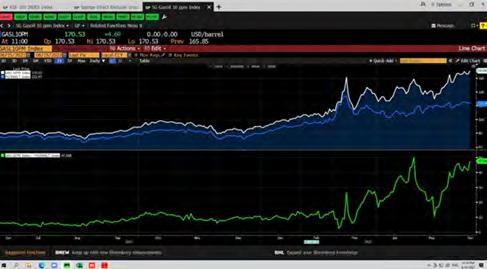
4 minute read
What imperils the mobile phone in
OPINION
Ammar H. Khan
Advertisement
A primer on refinery margins
restricted supply, coupled with geopolitical volatility which keeps Russian oil reaching its traditional markets, price of oil and its derivative products has increased significantly globally. As demand for refined products, mainly petrol and diesel keep on increasing, the price for the same also increases at a much higher rate than the price of To a casual observer, refining is a boring and largely commoditized business often exposed to volatility in commodity prices. During the last few months, as a consequence of supply constraints, refinery shutdowns, geopolitical volatility, and increasing demand for oil products, refinery margins exploded, increasing by more than four times of crude oil, mainly due to restricted refinery operations globally. In the Middle Eastern energy markets, on average the difference between a barrel of petroleum and a barrel of crude oil (refined v/s crude) was in the range of US$ 10 per barrel. However, due to increased demand, and restricted refining capacity, the same has increased to more than US$ 50 per barrel during the last few weeks, effectively increasing by more than five times. Similar trend has also been observed in the case its historic range as refineries globally could not keep up with increased of diesel prices globally, with only respite being available once more demand for refined products. refinery capacity comes online, or demand tapers off. The economics of a refinery is largely dependent on the Gross Refinery Margin (GRM). Simply put, the GRM is simply the difference between the total value of petroleum products produced by a refinery, and the price of crude oil. A refinery uses crude oil as an input, which then goes through something called a fractional distillation process. The crude oil is heated in a furnace, and at various temperatures different products are derived from the crude oil, ranging from asphalt (used in road construction), to fuel oil (used in power generation equipment), diesel, kerosene, petrol, and other products. In-effect each barrel of oil contains different products which are then sold off separately. A refinery essentially separates the products from the crude oil, and is profitable if the weighted value of products sold is greater than the cost of procurement of crude oil. As an example, if a refinery receives US$ 140 from the sale of products refined from one barrel of crude oil that costs US$ 130, then the Figure 1: Price of Gasoline (white), Price of Crude oil (blue), Refingross refinery margin is $10 per barrel. To enhance profitability, refineries ing margin (green) - US$ / barrel keep optimizing its product mix in order to maximize profitability. For Higher margins have led to rebuke from politicians globally, example, fuel oil is a low to negative margin product for local refineries, with a former finance minister of Pakistan also suggesting that refinbut it is still produced at a loss, such that profits from higher margin prod- ing margins be capped by the government. Such knee-jerk reactions ucts such as petrol, and diesel can compensate for the same. set a bad precedent wherein capping profitability would also lead While evaluating prices of petrol and diesel at the pump, a thumb- to an expectation that there should also be a floor on losses. A state of-rule approximation that people make is with the price of crude oil per should generally stay away from mandating caps, and floors on prices barrel, which may be a flawed comparison as a barrel of crude oil just – the consequence of which is rarely desirable in the mid to long term. doesn’t include petrol, and diesel, but many other products. The energy Refineries in Pakistan are still using decades old technology and are markets right now are in a flux, due to underinvestment in supply and rarely in a position to invest heavily in upgrades given heightened refining infrastructure over the last few years, ability to increase supply in sovereign risk. As our neighbor to the East imports Ural crude (from the short-term is restricted. As the economy recovers from the pandemic, Russia), and exports finished product, capitalizing on a market opthe demand continues to increase. Due to a mix of increased demand, and portunity, our local refineries can’t even meet local demand, let alone export any surplus. Due to lack of refining capacity, we are stuck with importing more expensive refined products, resulting in higher The writer is an outflow of foreign exchange. In the case of commodities, the cyclicality is clear. After every shortage, there is a glut, the independent demand and supply dynamics will readjust and prices may find a new equilibrium. However, it remains essential that macroeconomist and the country finally puts in place a refinery policy which is forward looking in nature, and actually leverages the strateenergy analyst. gic location which is more suited to fables now than real economic strength. Establishing and upgrading refineries to meet local demand, while re-exporting the surplus to the region, and beyond needs to be a core pillar of any macroeconomic growth strategy of the country. Ignoring this crucial component of the energy value chain may not bode well for future energy security, and will keep the country susceptible to vagaries of the international commodity markets.








